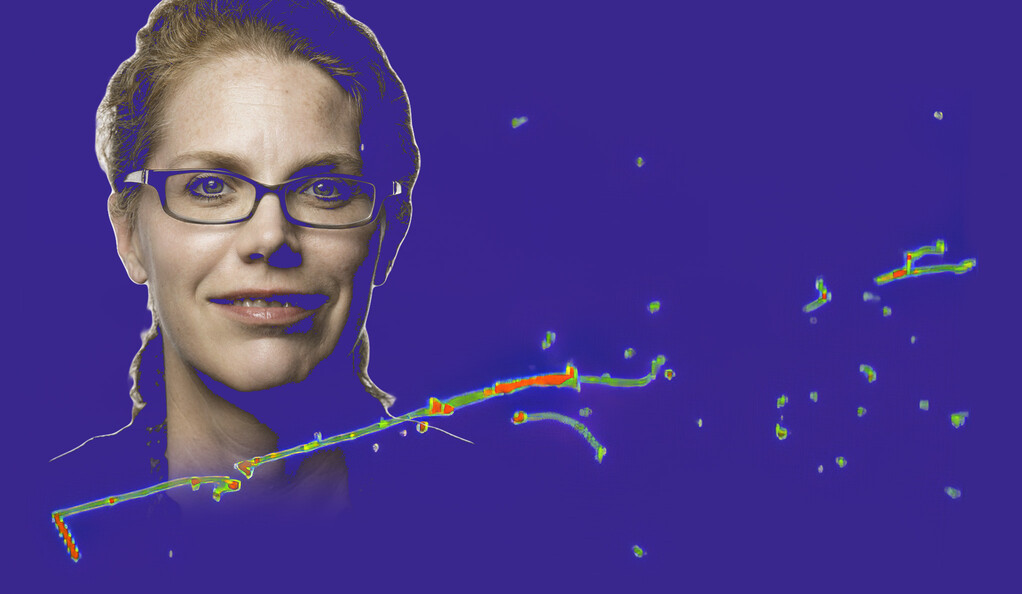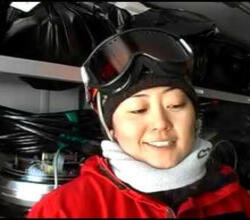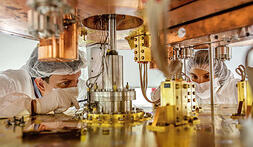Research & Discovery Archive
Yale-led MicroBooNE experiment’s first results show no hint of a sterile neutrino
 |
Researchers in the Yale High Energy Physics group, led by Wright Lab professor Bonnie Fleming, along with the Micro Booster Neutrino Experiment (MicroBooNE) collaboration, have been searching since 2008 for evidence of an anomaly, first seen in a previous experiment called MiniBooNE, that could potentially have been a theoretical new particle called the sterile neutrino. If evidence of a sterile neutrino were found, it would require scientists to reconsider what is known as the “Standard Model of Particle Physics” and be a radical shift in our understanding of the basic building blocks of the universe. Read more. |
Graduate student Backes builds dark matter detector and community
|
Backes has been awarded two fellowships by the department and has been very active in advocacy, service, outreach and educational programs while at Yale. Read more. |
Kelly Backes has been a crucial member of the team developing the HAYSTAC axion dark matter experiment, working with Wright Lab professors Steve Lamoreaux and Reina Maruyama. Backes implemented the first quantum squeezed state receiver system in a particle (astro) physics experiment, bringing together the fields of quantum information and particle physics in an unprecedented way. She designed the RF circuitry that controls the squeezed state receiver, couples it into the RF cavity that is the heart of the detector, and also guides signal paths to the data acquisition system. She wrote the acquisition and analysis software packages to control the squeezed state receiver system and incorporated computational parallelization. Backes also independently developed the software package that will acquire months of continuous dark-matter-sensitive data and control the mechanics of the experiment, including the optimization and alignment protocol for the quantum-limited amplifier system. Her research supervisor says this will be a watershed breakthrough in the axion dark matter field. Read more. |
Maruyama leads COSINE-100 experiment to investigate dark matter mystery
 |
Astrophysical evidence suggests that the universe contains a large amount of non-luminous dark matter, yet no definite signal of it has been observed despite concerted efforts by many experimental groups. One exception to this is the long-debated claim by the DArk MAtter (DAMA) collaboration, which reports that it has been regularly directly detecting a dark matter signal since 1997 in its sodium-iodide detector array. COSINE-100, based at an underground, dark-matter detector at the Yangyang Underground Laboratory in South Korea, has been taking data since 2016 to explore DAMA’s claim. COSINE-100 is the first experiment sensitive enough to test DAMA and use the same target material of sodium iodide. Yale Physics and Wright Lab professor Reina Maruyama, the principal investigator of the COSINE-100 experiment, said, “If we don’t see anything, then I think the community can really move on and focus on clearing up the dark matter landscape.” She continued, “If we see a signal? I think we’d really open up the field. And that’s really exciting.” Read more. |
STAR Result: Charm Quarks Offer Clues to Confinement
 |
Yale Physics and Wright Lab professor Helen Caines is co-spokesperson of the STAR Collaboration, which has recently released a new result that may redefine how nuclear physicists understand hadronization, the process of how particles called quarks and gluons combine to form hadrons, which are composite particles made of two or three quarks. The measurements, published in Physical Review Letters, revealed many more three-quark hadrons than would have been expected by a widely accepted explanation of hadronization known as fragmentation. The results suggest that, instead, quarks in the dense particle soup created at RHIC recombine more directly through a mechanism known as coalescence. Read more. |
Latest CUORE release improves understanding of the neutrino
 |
Wright Lab researchers, part of an international collaboration called the Cryogenic Underground Observatory for Rare Events (CUORE), are searching for evidence of a rare particle process called neutrinoless double-beta decay. Finding it would have profound implications for understanding neutrinos — the ghostly, plentiful particles that pass through most matter in the universe without being affected themselves. The process might also help explain why there is more matter in the universe than antimatter (which has the same mass as matter, but an opposite electric charge). While the new result did not show evidence of neutrinoless double-beta decay, it yielded a better idea of a neutrino’s mass during such a process. The CUORE group at Yale has been responsible for the design, construction, and commissioning of the CUORE Detector Calibration System, in the analysis and simulation of CUORE and CUORE-0 data, and in research and development for CUPID, the successor to CUORE. Read more. |
